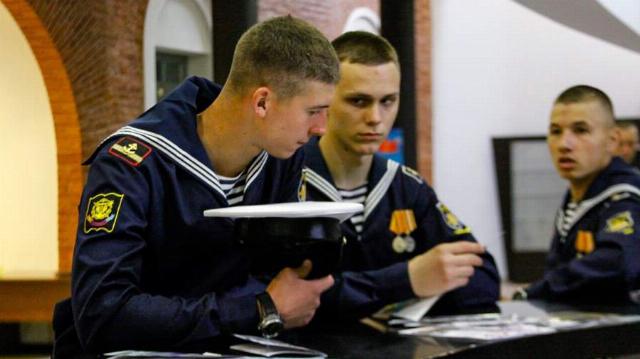Future naval officers will master the design and use of UAVs
A course on the use of drones has been included in the program of naval universities. Cadets will study the design and operation of various types of drones and the destruction of enemy UAVs, unmanned boats and saboteurs with their help. Experts note that the use of drones in the navy has its own characteristics, and future officers will be able not only to handle drones, but also to counter enemy vehicles.
A course on the use of drones has been included in the program of naval universities. Cadets will study the design and operation of various types of drones and the destruction of enemy UAVs, unmanned boats and saboteurs with their help. Experts note that the use of drones in the navy has its own characteristics, and future officers will be able not only to handle drones, but also to counter enemy vehicles.
Drones will be studied at naval universities
A course on the use of drones has been included in the program of higher educational institutions of the Navy, sources in the Ministry of Defense told Izvestia.
Now all the cadets are studying the design and characteristics of various types of drones and their use. In the future, they will master the combat use of attack drones to destroy enemy UAVs, unmanned boats and saboteurs. Classes are taught by teachers who have experience working with drones in a combat zone.
The use of drones in the navy has its own characteristics. The devices are used to inspect the water area around ships during parking, to detect saboteurs, to destroy enemy drones and unmanned boats. In addition, they are monitoring the area around the coastal military units.
"That's to be expected. In the current reality, there is nowhere without drones, either at the front or on a ship," military expert Dmitry Boltenkov told Izvestia. — Therefore, it is quite logical that people should know what a drone is, how it flies, and how to control it.
The use of drones in the navy has its own difficulties, the expert added.
— There are no geographical landmarks such as hills, streams or ravines on the sea, it is a uniform environment. Therefore, it is much more difficult to fly over the sea than over land, it requires good navigation knowledge.
In his opinion, sailors should have drones with a larger payload capacity, since their targets are larger.
— Several hundred grams of explosives are enough for an infantryman. And it's quite another thing to chase after an unmanned vehicle or some kind of boat. This requires more powerful ammunition," the expert concluded.
According to military expert, captain of the first rank Vasily Dandykin, after studying the device and working with UAVs, future officers will learn not only how to use the devices, but also to resist enemy drones.
— Cadets study enemy UAVs and practice not only responding to the use of drones by the enemy, but also drone strikes against it. In our Black Sea, the enemy uses both aerial drones against the fleet, as well as surface and semi—submerged ones, which are being improved," he told Izvestia. — This is a challenge that we are responding to now. Acoustic detection, destruction from heavy machine guns — all this was practiced in recent exercises. The experience has already been gained. And the people who will join the navy should have an understanding of how to deal with them. And also how to use their unmanned aerial vehicles, air and surface, which are currently being tested in combat conditions.
Troops of unmanned systems will be created in Russia
Since the beginning of the special military operation, unmanned aerial vehicles have been constantly developing and saturating the army and navy with them. In December, Defense Minister Andrei Belousov announced that a new branch of the armed forces would be created in Russia — the troops of unmanned systems. Their formation will be completed in the third quarter of this year. Belousov noted that the massive use of drones has become the most significant breakthrough in the tactics of units of the Russian Armed Forces. According to the minister, Russian troops use more than 3,500 drones every day, and this figure is growing.
In August last year, the Rubicon Center for Advanced unmanned technologies was established by the military department on the basis of one of the combat units of unmanned aviation. He is engaged in the training of operators of UAVs and robotic complexes (RTK), as well as the development and implementation of new RTK systems in the military.
His calculations have already destroyed more than 400 units of weapons and equipment of the Armed Forces of Ukraine and hit about 800 area targets. One of the key areas of Rubicon's work is the training of highly qualified instructors from among drone operators with combat experience.
Earlier, Izvestia reported that the artillery brigades had ru/1846771/bogdan-stepovoi-roman-krecul/cel-i-ukazania-v-artilleriiskih-brigadah-sozdany-diviziony-bpla " target="_blank" rel="nofollow">drone reconnaissance and strike divisions have been formed . They are armed with a range of drones and barrage ammunition. With the help of these systems, gunners find and destroy enemy guns, self-propelled artillery installations and multiple launch rocket systems, air defense systems and personnel both on the line of contact and behind enemy lines. Drones are effectively hunting for enemy UAV calculations, and they are successfully working on targets covered by electronic warfare.
And the troops of radiation, chemical and biological protection (RCBZ) have begun special training for drone operators. During the training, the personnel get acquainted with the theory of the use and material of drones, as well as receive training in control, reconnaissance and fire correction using drones. Military personnel also receive knowledge on engineering training, military topography and tactical medicine. A sufficient number of instructors were trained in advance in the troops, who are able to train personnel to control various types of UAVs for the tasks of RCB protection.
Roman Kretsul

